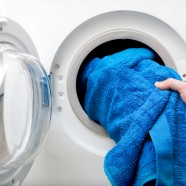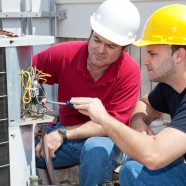Want a Free Vacation? Tips for Electricity Savings You Can Bank On
Money has rarely been tighter, which can make you feel more stressed out every day. It’s the perfect scenario for needing a vacation, but who can afford a weekend away? You can, if you follow these small changes and stick with them for a year. Some of them you can install with the help of a licensed electrical contractor, but the rest are switches you can make yourself. Whether you’d like a few days away with the kids or a romantic weekend away from home, you can bank enough money from electricity savings to pay for it by the end of the year.
Changes to Make with Your Electrical Contractor’s Help
Even the handiest handyman (or -woman) needs help with some jobs, especially when it comes to installing electrical appliances. It’s much safer to trust a licensed electrician to do a professional job than to do even a competent amateur job. You’ll know the job is done right, and you’ll save money by avoiding the inevitable redo that shoddy jobs call for. Some of the ways your electrician can help you save money are:
- Installing a hot water heater timer. You’re not home all the time, and you definitely don’t take showers all hours of the day and night. Why spend money heating water you’re not going to use. An electrician can install a water heater timer for a savings of about $25 per year.
- Get a smart meter. Check with your electricity company to find the availability of these meters in your area. If they’re available, your electrician can install them, replacing your old meter. These new, more sensitive meters have the ability to shut off power to your home for a short time, lightening the power load in times when it’s needed most for the community. Most electric companies offer a reward for using these meters, and you can achieve up to $140 a year in electricity savings by using one.
- Install smarter switches. Outdoor lighting can be a great safety feature on a house, but it costs a lot of money to have those lights running all night long. Have your electrician switch out the traditional lights for ones with a motion sensor switch. The lights will go on when anything moves around your property, and go back off when all is calm. Smarter switches can work inside the house, too. Set timers on the fans in your home, including a timer that will turn each fan off after a certain length of time. Adding these two details to your home can net you around $100 a year.
Changes You Can Do Yourself
Some changes are so simple you can do them yourself. You’ll save a surprisingly large amount of money making these easy changes, without ever having to consult a professional:
Buy Energy Star appliances. If you’re in the market for a new refrigerator or stove, do your research to find the most energy-efficient model that fits your lifestyle. Energy Star models show their average savings right on the label. These appliances can save you between $35 and $600 a year.
Service your air conditioner. This simple task doesn’t take a professional to complete it. If you hose out the inside, straighten the fins, lubricate the motor, and change the filter, you can save up to $65 next year.
Kill energy vampires. According to the Department of Energy, 75 percent of the electrical use by home electronics happens when they’re shut off. These appliances are always in stand-by mode, which takes a constant source of power to maintain. Unplugging your computer, stereo system, and television can cut around $100 from your bill each year.
Change your furnace filters. Yes, it’s time-worn advice, but that doesn’t make it useless. Changing a furnace filter is almost always a matter of sliding the old one out and sliding a replacement in. It takes about a minute, and saves you about $5 a month, or $60 every year.
Read MoreHow to Get Electrical Energy Savings Through Small Habit Changes
With electrical energy costs rising every year, it makes sense to do what you can to limit the power your household is using. While updating an entire house can significantly lower your energy usage, smaller changes can add up to surprisingly large savings. Contract a professional electrical contractor to come up with a plan for small, gradual changes to make on your home. An experienced electrician can alert you to spots where you’re wasting power as well as newer technology to waste older, power-hungry versions you already have installed. Any one of these changes can result in enough electrical energy savings to lower your monthly power bill, and combining a few could end up saving you hundreds of dollars every year.
Save on Heating and Cooling
Your HVAC system is one of the biggest energy users in your home, giving you lots of leeway in which to save money. Even small changes in your habits can add up to large electrical energy savings every month. It’s common knowledge that you should set your thermostat around 72 degrees F in the winter and 78 degrees in the summer. This is the average good compromise between comfort and energy savings. That’s a great idea, but what about the times you aren’t even in the house or actively using the space? When the whole family goes to school and work, there’s no sense in keeping your living space at an optimal temperature. The same goes for winter nights, when everyone is snuggled under blankets. Changing the indoor temperature during these down times is a great idea, but who can remember to do it every day? When your electrical contractor installs a programmable thermostat, you can set the ideal temperatures for multiple times each day, and it will automatically change the temperature for you. No more having to remember changes every morning and night.
Save on Electric Lights
Electric lights are, in most homes, the biggest drain on the electrical budget. They’re everywhere, in every room, and it’s easy to forget to turn them off. This can add up to double-digit wastage every single month. The best way to combat this problem is to have your electrician install a programmable light timer. Find ones that work on multiple lights, and set them to go off when you know the house is empty. If you have an outdoor light for security reasons, set a timer there to go off after a few hours, or install a motion sensor for even more savings.
Turning the light off will save you money, but you’ll find even more electrical energy savings when the lights themselves save you money, even when they’re on. According to Energy Star, if every home in the country replaced one bulb with a more efficient one, we’d collectively save about $600 million in energy costs each year. LED light bulbs might seem pricey at first, but considering the fact that they use a fraction of the power compared to traditional bulbs, plus they last for years, they’re really a power bargain.
Save on Electric Appliances
Even the most frugal person can miss out on savings by skipping a trick or two. One way to catch every spot you miss to get the biggest savings possible is by having your electrical contractor install an electrical usage monitor. This device checks where the electricity is going in your home and how much of it is wasted. The programmable system will check:
- Energy vampires, those appliances that suck power even when they’re turned off
- Large appliances such as refrigerators and space heaters that use more power than they should
- Random lights that are constantly left on when they shouldn’t be
- Sudden periods of higher than average usage, which can indicate wasteful behavior or changes in your electrical usage
Once the system is installed, a quick check once a day will tell you where your power is going, and what items you can change in order to save even more money.
Read MoreSaving Energy Costs by Changing Small Habits
It’s the little things in life that make the most impact. The experts can do studies all day long about the average cost of using each appliance, but it’s the actual way you use it that determines how much you’re going to have to pay. Changing out light bulbs for efficient LED lights and replacing old appliances with new and greener versions is a good start toward saving energy costs, but your daily habits can undermine all that good planning if you’re used to squandering power. Take a look at the way you habitually use your appliances to see if you’re secretly wasting energy without even knowing it.
Washer and Dryer
Your washer and dryer can each cost over $100 a year to operate, so getting the most efficient use out of each one should be high on your frugal savings list. Setting up your laundry the right way and doing it all on one day is the way to start. Drying clothes one batch after another will take advantage of the residual heat, saving dryer electrical costs. Separate your clothes into lighter loads and heavier ones, and dry the lighter ones outdoors if possible. Pull the clothes from the dryer before they’re completely dry and hang them up for a wrinkle-free wardrobe. Never run a partial load, of course, and never run the dryer without first emptying the lint filter for the most efficient use.
Stove and Oven
If you’re trying to save money you’ll have to cook every day, as eating out constantly won’t be an option. Common sense use with your stove and oven can result in significant savings.
- Cook elsewhere whenever possible. Use a toaster oven for small pans of food and grill outside during warm weather to save oven energy as well as air conditioning costs
- Use the oven efficiently. Keep the door shut until at least the minimum cooking time has passed, to save money on lost heat. Turn the oven off five minutes before baked goods are done, and ten minutes in the case of meats. The residual heat will finish cooking without loss of food quality.
- Use smaller pots on smaller burners, and cover them with tight-fitting lids as often as possible. Change your pots to those with copper bottoms for the most efficient heat distribution.
- Buy or make stove reflector pans to place around burners. The shiny surface will reflect the heat and direct it upward instead of it being lost out the sides. Your grandmother and her aluminum foil around her burners was right.
Refrigerator and Freezer
Depending on its age and use, your refrigerator/freezer can be the most expensive appliance in the house. Fortunately, it’s also the one appliance that the easiest to save money with, just by changing your habits and usage.
- Start by always keeping your freezer full. The motor runs more efficiently if it doesn’t have to cool empty spaces. If you don’t have enough food to fill the space, fill milk jugs with water and use them to fill the empty spaces.
- Keep it clean to keep it efficient. Clean the rubber gaskets around the doors to remove any food or debris that can keep it from forming an airtight seal, and replace any gasket that’s cracking. Also, vacuum the fan on the back of the refrigerator once a month. Excess dust makes the motor work overtime, and clearing the area will smooth the way to saving energy costs.
- Change the refrigerator temperature to 38 degrees. You’ll still keep your food cold without allowing it to go into the food safety danger zone, but you’ll save energy by raising the temp a bit higher above freezing.
- That fridge in the man cave? If you’ve got one, replace it with a smaller apartment-sized version or, better yet, a cooler with a bag of ice. Donate the family sized version to a charity that will haul it away.
Miscellaneous
Even smaller changes can reap big savings. Did you know that the average small electric room heater costs around $300 a year to run? They among the most inefficient pieces of equipment you might have in your house. Substitute warm socks, slippers, sweaters, and electric blankets, and insulate your windows to prevent drafts in the winter so you can get rid of that energy waster.
Use kitchen and bath fans to remove moisture and smoke, but turn them off immediately after you use them.
Turn your dishwasher to economy mode to save water and electricity, or do the dishes by hand once or twice a week.
Read More
5 Lighting Tips for Electric Energy Savings
A light bulb is a light bulb, right? Not any more. Gone are the days of incandescent bulbs in all regular lamps and one kind of fluorescent bulb in utilitarian settings. Today’s light bulbs are greener, come in a huge variety and, most importantly, save energy and money. Whether you’re shedding light on a home reading corner or in a restaurant kitchen, you can find a bulb that uses less energy while having less impact on the environment.
Home Lamps
Replace all of the bulbs in your home lamps with CFL bulbs. These compact fluorescent lights are much more energy efficient while giving off the same amount of light. Unlike the older halogen bulbs, which can get hot enough to cause a fire. CFL bulbs save energy without the danger. You can find CFL bulbs in a multitude of sizes and shapes, from common lamps to unusual ceiling spots. They come in a variety of light colors, from warm tones to the starkest blue-white.
You’ll also get a large amount of savings by replacing older bulbs with LED lights. These lights are very bright and give off no heat whatsoever, so they’re safer to use where children will be in the area, and can be extremely energy-efficient.
Outside Lighting
Businesses and homes rely on outside lighting both for security and for esthetics. While a building that’s lit all night long might be safer and look better, it can turn into an energy suck in very little time. This doesn’t mean you have to pull out your outdoor lighting system, only that you should adjust your lighting methods. Set a timer for your outdoor lights to go on and off, and make sure to adjust it as the seasons change. Save even more money by installing a motion detector for all your outdoor lights. It will serve as an even better security method by adding the element of surprise, while still allowing visitors to admire your landscaping.
Lamps
Find the five lights that are used most often in your home or business and replace them with ENERGY STAR products. Each light with an efficient substitute can save you a significant amount of money in a year, and replacing the five most-used ones can give you a surprising amount of savings. Increase the savings by replacing the rest of the lampshades in the home with translucent shades. More light will stream through into the room, allowing you to switch to a lower wattage bulb, giving you even more electric energy savings.
Fluorescent Tubes
In rooms where utility is more important than looks such as a nursery, kitchen, or craft room, change up your traditional lighting and install fluorescent tube lighting. While not fancy, these lights give off much more light while using less energy than comparable incandescent bulbs. If you already have fluorescent lighting in your utilitarian rooms, change the ballasts to newer, energy-saving versions to give yourself a break on your electric bill.
Rearrange
Don’t light an entire area of the house if you normally only use one small portion of a room. It’s customary to turn on the lights when you come home at night, or when it gets dark, but there’s nothing wrong with having a few dark rooms in your home. Most people have their favorite spot or two that they like to curl up in at the end of the day. Instead of lighting the entire room, add a smaller lamp with a pinpoint light if you usually read or crafts in that seat. With the light being closer to your eyes, you can use a more energy efficient bulb with a lower wattage while still having enough light to enjoy your relaxing activities. Install tiny strings of bulbs along stair risers to light the way without needing a hall light turned on, and place small reading lamps just above each pillow to allow for reading in bed without using excess energy.
Read MoreHow to Achieve HVAC Energy Savings for Your Home
The percentage of energy you use changes depending on whether you live in southeast Florida or the northern tip of Maine, but about half of the total energy you use in your home goes directly to air conditioning and heating costs. Heating, ventilation and air conditioning, or HVAC, is also one of the most obvious ways in which to save money on home energy bills. Its usage is such a large chunk of your total energy costs, even changes that result in small percentages of savings can make a big difference. It’s the simple things that count, and taking care of small tasks that most people overlook is a great way to find HVAC energy savings all year long.
A New Thermostat
Older thermostats are often inaccurate due to extended use, plus they’re static machines. Set a thermostat at 68 degrees, and that’s where it will stay. Newer programmable thermostats have the ability to be more flexible. You program in the temperature you want during the day when you’re home, then set the temperature back another few degrees for when you’re sleeping or at work. You’ll save money by not heating or cooling the building while you’re not there, or when you’re under your covers or in front of a fan, then the thermostat’s timer will turn the temperature back to normal just in time for your home to be comfortable when you arrive. It’s a simple job for a commercial electrician to install a programmable thermostat, and the savings can pay for it in just a few months.
The Air Filter
Pull out your air filter every month and check to see if it’s dirty. If it’s soiled, throw it away and replace it with a new, clean version. Replace the filter at least every three months, but you may need a monthly replacement during heavy usage times in the heat of summer or the middle of winter. A clogged filter doesn’t allow air to pass through as easily, making the machine work harder and using more energy in the process. Replacing the air filter on a regular basis will extend the life of your HVAC system, putting off any repair or replacement costs to farther in the future.
Heating and Cooling Ducts
You can have a very well-insulated home, but if the ducts to your heating and cooling system aren’t sealed properly you’re going to lose energy from multiple points in your home. Concentrate first on the ducts that run through the harshest weather spots in your home: the attic, the crawlspace, the basement, or through an unheated garage. Use metal-backed or foil tape, or duct sealant, to seal all the seams and connections to these ducts. After they’ve been sealed, wrap them in ductwork insulation to keep them from getting hot in the summer and cold in the winter. After these ducts have all been sealed properly, find and seal any ducts in the main portion of the house.
ENERGY STAR Equipment
If your appliances are more than 10 years old, it may be time to replace them for a better running and more energy-efficient model. Do your research and compare energy usage between different models. Often the less expensive model of a refrigerator or backup generator is more expensive in the long run than those with ENERGY STAR certification. The same holds true for a new HVAC system for your home. Installing a more efficient heating and cooling system can give you significant HVAC energy savings throughout the year.
Upgrade Lighting Systems
Older fluorescent lights, as well as incandescent bulbs, put out a lot of heat while they’re being used during the day. This can result in the ambient temperature in your home or business to go up, causing the air conditioner to have to work harder. Newer LED lights are more efficient because they use less power to create the same amount of light, and they also give off a small fraction of the heat that older lighting styles do. Replace all your old bulbs with newer energy-efficient LED lights to decrease the temperature inside.
Read More4-Point Checklist for Critical Electrical Maintenance in Your Business
Electrical down times cost your business money, through higher repair bills and loss of business if you have to close. The best way to prevent most electrical system problems in your business is by creating and following an electrical maintenance service schedule.
Find a service professional who will walk through your business with you and find all the systems and equipment that need maintenance on a regular basis. From basic lighting to intricate machinery, your business’s electrical equipment will have fewer problems if you anticipate them and take care of the problems before they arise. Follow this 4-poimt electrical maintenance checklist to make sure you don’t overlook anything important:
#1: Generator Maintenance
The danger of a power outage in Florida is high in any given week, and much more so during the six months of the year that make up hurricane season. Lightning, tropical storms, hurricanes, and even traffic accidents can cause your business to lose power, and without power you’ll probably have to close your doors. Whether you need lights and air conditioning in an office or refrigeration to keep thousands of dollars of expensive food safe in a restaurant, it’s crucial that you keep the power running, no matter what happens outside.
Maintaining your backup generator should have the biggest priority on your service list, and your contractor will determine what maintenance will be needed, the lifespan of your generator’s parts, and how often the unit should be serviced.
#2: Lightning Protection Maintenance
Florida receives more lightning strikes per square mile than any other state in the country. This not only poses a danger to the power grids, it is also a threat to your business building itself. A solid lightning protection system can ensure that any lightning strikes that hit your building are directed away and into a grounded portion of the property, reducing or eliminating the chances of property damage from the storm. Like any other equipment, lightning protection has to be properly maintained:
- The physical parts of the system must be inspected on a regular basis, tightening fasteners and replacing worn parts, as needed.
- Surge protectors should be checked and tested regularly to make sure they’ll function properly when called upon.
It may seem like an inert system, but lightning protection should be an important part of your electrical maintenance schedule.
#3: Lighting System Electrical Maintenance
Changing a light bulb can seem like a simple task, but if you lose your light at a crucial part in your work day, you can lose a substantial amount of money, or worse. The correct lighting levels can make your clients happier, and will create a more productive work place, so keeping your lighting at optimum levels is a key part in maximizing your profits.The best way to ensure this is happening is to schedule regular lighting system maintenance with a professional contractor.
An experienced electrical professional will know how to replace older incandescent bulbs with newer, energy efficient LED lights. He’ll check and replace bulbs, inside and out, on a regular schedule. Wiring can become a problem, especially in older businesses, and inspection and repair will be an important part of your electrical maintenance schedule. Stopping problems before they start is the most cost-effective way of doing business, and keeping your power on is the best way to keep your business safe and open, without incurring expensive repair costs.
#4: Equipment Maintenance
Every piece of equipment in your business has a recommended maintenance procedure, from checking and maintaining gaskets to lubricating moving parts. A commercial electrical professional contractor will inspect all the equipment on your property and determine an efficient and effective schedule of electrical equipment maintenance tasks. Your equipment represents a major investment, and even those minor pieces that are only used on an occasional basis can cost a lot of money to repair.
Following the manufacturer’s recommended maintenance plan not only ensures the best possible chance that the equipment won’t break down, it will keep your machines within their warranty guidelines, possibly lowering or eliminating any repair or replacement costs. Besides, well-maintained electrical equipment helps you to realize the industrial energy savings you want.
Read More






Recent Comments